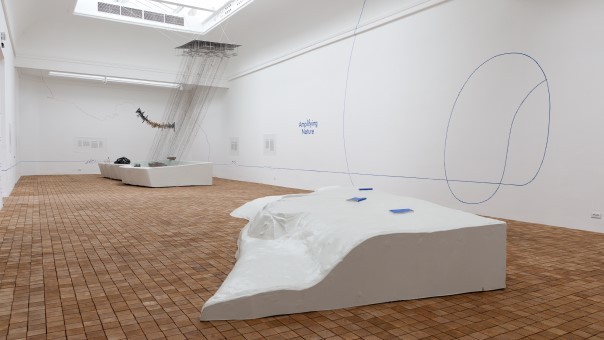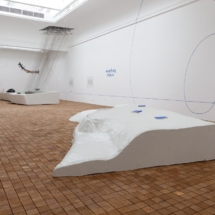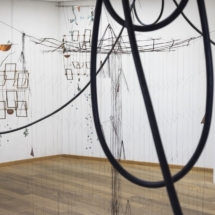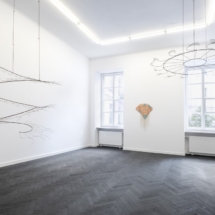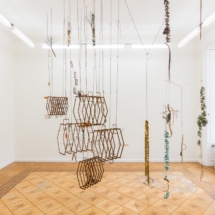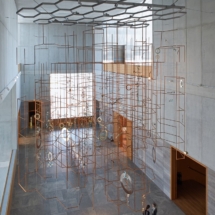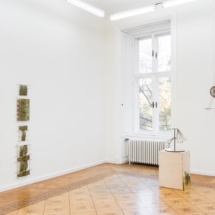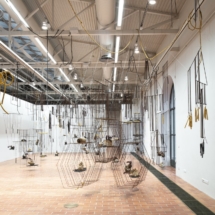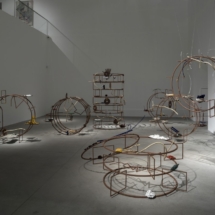Working from her home – a farm in the small village of Koplany in Eastern Poland, artist Iza Tarasewicz (B.1981) utilizes raw materials and rural systems of production to create complex spatial installations. Her works often take the form of modular, flexible, mobile, and reconfigurable display systems that combine a raw and modest functionalism with formal logics found in the natural world, scientific experimentation, graphs and diagrams. Creating clusters of sculptures that resemble three-dimensional drawings or in her words ‘diagrams of possible architectures’ she uses both organic and inorganic materials to map relationships between cellular, social, agricultural, and celestial interactions.
At Tramway, part of Glasgow Life, Tarasewicz traces her own agricultural origins, creating a new body of work inspired by folk traditions and the circular relationships between protest, farm labour, dance, rhythm, and collectivity in rural communities. Previously Tarasewicz has examined these through the analysis of Mazurka, a globalized music which originated from a serf work rhythm in 16th century Poland where villagers would thresh grains with flails to a collective beat.
Tramway’s main gallery hosts an installation consisting of fragments of retro agricultural machines that have fallen out of use. Tarasewicz describes them as “traumatized objects”, tools and contraptions abandoned as the chain of modern production has shifted due to progressing ecological catastrophe, monopolization of production, and as with the current situation in Ukraine, war. Re-invigorated in the space of the gallery, these apparatuses are arranged to form their own alternative community and culture, inspired by punk machinery, turbo whirls, folk rhythms, craft and the cycles of labour and life. Combining these archaic agricultural implements with futurist visions, Tarasewicz resurrects these once obsolete objects as modes and models for future survival emphasising both the essential value of, and the threat to, agriculture, through war and the social and ecological unsustainability of global food supply chains and industrialized farming.
A key component of the exhibition is a series of hanging assemblages inspired by Mazurka’s circular and repetitive rhythms. Made of dense forests of delicate metal rods, suspended sculptures generate an abstracted choreography, framing the larger works and the rest of the exhibition. These sculpturally gestural structures also collate and display a library of raw materials such as plant fibres, iron oxide and clay. Tarasewicz interprets this matter as embedded information, layers of meaning which are metabolized and organized within a productive system.
The exhibition is accompanied by a new movement-based work by Polish dancer and choreographer Pawel Sakowicz realised in collaboration with Glasgow based dancers. Responding to the forms and rhythms of the exhibition, the performance invokes a contemporary language for Mazurka’s traditional cyclical forms.
The performance choreographed by Pawel Sakowicz will take place within the exhibition in the gallery space at Tramway, part of Glasgow Life, at the preview on the evening of October 7th and on the afternoons of Saturday 22nd October and Saturday 5th November.
Iza Tarasewicz Bio
Iza Tarasewicz (b. 1981 in Białystok) graduated from the Faculty of Sculpture and Performing Arts at the Academy of Fine Arts in Poznań in 2008. She lives and works in /B a small village near Białystok where she was raised. Working in sculpture, installation, drawing, and performance, her work has garnered significant acclaim both at home and abroad. She was the winner of the 2019 Bayerischen Kunstförderpreise in Fine Arts and the winner of the VIEWS [Spojrzenia] 2015 Deutsche Bank Foundation Award, the premiere prize for young art in Poland, co-organized with Zachęta National Gallery of Art in Warsaw. In 2013, she was a nominee for the Passportu Polityki Award for Visual Arts. In 2016 she participated in the 32nd Bienal de São Paulo, 5th Moscow International Biennale for Young Art, and the 11th Gwangju Biennale, and in 2018 she represented Poland at the 16th Venice Architecture Biennale in collaboration with Centrala. Recent solo exhibitions include: Loop De Loop, BIKINI, Lyon, France
The Smallest Uninteresting Number, Centrum Aktywności Twórczej, Ustka, Poland Sorry for All the Ups and Downs, Syntax, Lisbon, Portugal, Ultra High TURBA TURBO III, Kostka Gallery, Meetfactory, Prague, Czech Republic, Turbulence Soon Appears, Trapéz Gallery, Budapest, Hungary, Reverse Logistics, BWA Warszawa, Warsaw, Poland, Equilibrium in Meteors, Galerija Gregor Podnar, Berlin, In myriads, things cry out, Croy Nielsen, Vienna, Austria, Once Information Has Passed into Protein, Museum of Fine Arts Leipzig, Leipzig, 2020: Disturbances and Multiplicities, State Gallery of Art, Sopot VARIABLES, Loggia, Munich, 2021, Signal Flow, Croy Nielsen, Vienna, Full Circle Ahead!, Gunia Nowik Gallery, Warsaw, THE MEANS, THE MILIEU, Arsenal Gallery, Bialystok.
Pawel Sakowicz Bio
Pawel Sakowicz (b.1988) is a choreographer and dancer. He creates his own choreographic performances, but also collaborates with theatre and film directors. His main artistic interests are the history of dance and the issues of cultural appropriation in choreography. Pawel’s works include: TOTAL, Jumpcore, Masakra, Drama, Amando and a sound installation Vortex. They have been presented in three editions of the Polish Dance Platform, at the Divine Comedy Festival in Krakow, La Biennale de danse du Val-de-Marne, Muzeum Susch, Santarcangelo Festival, NYU Skirball and CAC New Orleans, among others. pawelsakowicz.com
Tramway 2 Gallery
8th October to January 29th
This exhibition is supported by The Henry Moore Foundation.











